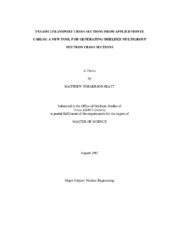| dc.description.abstract | This thesis describes a tool called TXSAMC (Transport Cross Sections from
Applied Monte Carlo) that produces shielded and homogenized multigroup cross
sections for small fast reactor systems. The motivation for this tool comes from a desire
to investigate reactor systems that are not characterized well by existing tools. Proper
investigation usually requires the use of deterministic codes to characterize the timedependent
reactor behavior and to link reactor neutronics codes with thermal-hydraulics
and/or other physics codes. Deterministic codes require an accurate set of multigroup
cross section libraries. The current process for generating these libraries is time
consuming. TXSAMC offers a shorter route for generating these libraries.
TXSAMC links three external codes together to create these libraries. The code
creates an MCNP (Monte Carlo N-Particle) model of the reactor and calculates the zoneaveraged
scalar flux in various tally regions and a core-averaged scalar flux tallied by
energy bin. The core-averaged scalar flux provides a weighting function for NJOY. The
zone-averaged scalar flux data is used in TRANSX for homogenization and shielding.
The code runs NJOY to produce multigroup cross sections that are tabulated by nuclide,
temperature and background cross section in MATXS (Material-wise cross section) format. This library is read by TRANSX which, in conjunction with the RZFLUX
(Regular Zone-averaged Flux) files, shields the cross sections and homogenizes them.
The result is a macroscopic cross section for the cell within the reactor from which the
RZFLUX file was written.
The cross sections produced by this process have been tested in five different
sample problems and have been shown to be reasonably accurate. For reactor cells
containing fuel pins, the typical error in the overall fission, nusigf, (n,2n), absorption and
total RRD is only a few percent and is often less than one percent. It appears that the
error is less for hexagonal lattices than for square lattices. A significant amount of error
is associated with threshold reactions like (n,2n) in the sodium coolant. For the square
lattice test problems, a reduction in error occurs when smaller tally regions are selected.
This reduction was not observed for hexagonal lattice reactors. Overall, the cross
sections produced by TXSAMC performed very well. | en |


